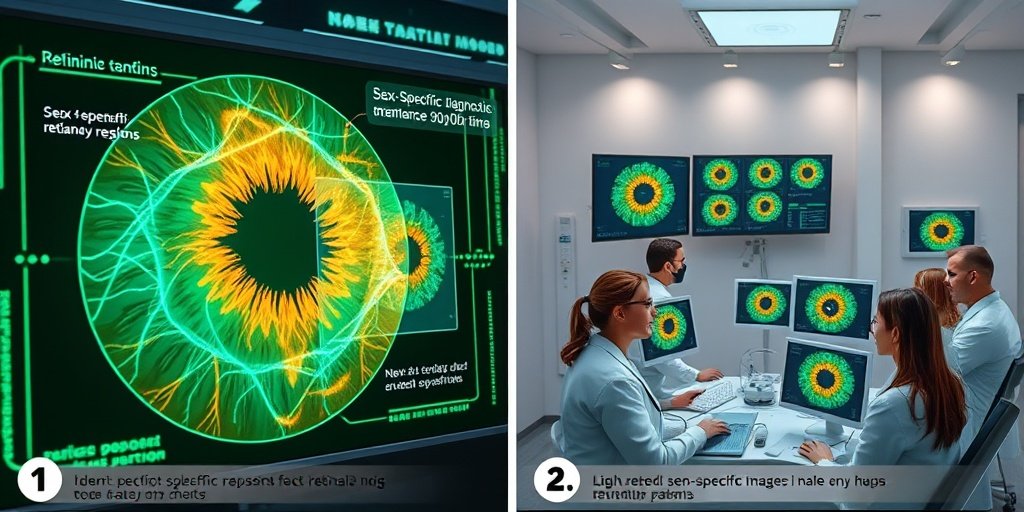⚡ Quick Summary
This study explores the use of AI-assisted techniques to identify sex-specific patterns in diabetic retinopathy (DR) through retinal fundus images. The findings suggest that DR may manifest differently in males and females, with implications for tailored treatment strategies.
🔍 Key Details
- 📊 Dataset: 2,967 fundus images from EyePACS
- 🧩 Features used: Retinal fundus images
- ⚙️ Technology: Convolutional Neural Networks (CNN) with explainable AI techniques
- 🏆 Performance: AUC scores of 0.72 and 0.75 for two VGG16 models
🔑 Key Takeaways
- 👁️ Diabetic retinopathy is a leading cause of blindness, necessitating regular monitoring.
- 🤖 AI techniques can enhance the identification of DR patterns based on sex.
- 📈 Saliency maps revealed different retinal regions of focus for males and females.
- 👩⚕️ Women may be at higher risk for developing macular edema (ME).
- 👨⚕️ Men may be more susceptible to proliferative diabetic retinopathy (PDR).
- 🔍 Further research is needed to explore these sex-specific manifestations of DR.
- 🌐 Study published in PLoS One, highlighting the importance of sex in DR diagnosis.

📚 Background
Diabetic retinopathy (DR) is a serious microvascular complication of diabetes that can lead to vision loss if not detected and treated early. Traditionally, factors such as age and severity of diabetes have been prioritized in DR diagnosis, while sex differences have largely been overlooked. Understanding how DR manifests differently in males and females could lead to improved monitoring and treatment strategies.
🗒️ Study
The study involved a comprehensive analysis of 2,967 retinal fundus images from a larger dataset of DR patients. Researchers matched male and female groups based on age, ethnicity, severity of DR, and hemoglobin A1C levels to minimize confounding variables. They employed convolutional neural networks (CNN) integrated with explainable AI techniques to analyze the images and identify sex-specific patterns.
📈 Results
The fine-tuning of two pre-trained VGG16 models yielded AUC scores of 0.72 and 0.75, indicating a significant ability to distinguish between male and female retinas. The use of the Guided Grad-CAM technique to generate saliency maps revealed that CNNs focused on different retinal regions: the macula in females and the optic disc and peripheral vasculature in males. This divergence from the saliency maps generated by CNNs trained on healthy eyes suggests distinct patterns of DR manifestation by sex.
🌍 Impact and Implications
The findings of this study have profound implications for the future of diabetic retinopathy management. By recognizing that sex-specific patterns exist in DR, healthcare providers can tailor monitoring and treatment strategies to better address the unique risks faced by male and female patients. This could lead to earlier interventions and improved outcomes for individuals at risk of vision loss due to DR.
🔮 Conclusion
This research highlights the potential of AI in enhancing our understanding of diabetic retinopathy and its sex-specific manifestations. As we continue to explore the intersection of technology and healthcare, it is crucial to consider how these insights can inform more personalized approaches to treatment. The future of diabetic retinopathy management looks promising, and further research in this area is essential.
💬 Your comments
What are your thoughts on the role of sex in diabetic retinopathy? How do you think AI can further enhance our understanding of this condition? 💬 Share your insights in the comments below or connect with us on social media:
AI-Assisted identification of sex-specific patterns in diabetic retinopathy using retinal fundus images.
Abstract
Diabetic retinopathy (DR) is a microvascular complication of diabetes that can lead to blindness if left untreated. Regular monitoring is crucial for detecting early signs of referable DR, and the progression to moderate to severe non-proliferative DR, proliferative DR (PDR), and macular edema (ME), the most common cause of vision loss in DR. Currently, aside from considerations during pregnancy, sex is not factored into DR diagnosis, management or treatment. Here we examine whether DR manifests differently in male and female patients, using a dataset of retinal images and leveraging convolutional neural networks (CNN) integrated with explainable artificial intelligence (AI) techniques. To minimize confounding variables, we curated 2,967 fundus images from a larger dataset of DR patients acquired from EyePACS, matching male and female groups for age, ethnicity, severity of DR, and hemoglobin A1C levels. Next, we fine-tuned two pre-trained VGG16 models-one trained on the ImageNet dataset and another on a sex classification task using healthy fundus images-achieving AUC scores of 0.72 and 0.75, respectively, both significantly above chance level. To uncover how these models distinguish between male and female retinas, we used the Guided Grad-CAM technique to generate saliency maps, highlighting critical retinal regions for correct classification. Saliency maps showed CNNs focused on different retinal regions by sex: the macula in females, and the optic disc and peripheral vasculature along the arcades in males. This pattern differed noticeably from the saliency maps generated by CNNs trained on healthy eyes. These findings raise the hypothesis that DR may manifest differently by sex, with women potentially at higher risk for developing ME, as opposed to men who may be at greater risk for PDR.
Author: [‘Delavari P’, ‘Ozturan G’, ‘Navajas EV’, ‘Yilmaz O’, ‘Oruc I’]
Journal: PLoS One
Citation: Delavari P, et al. AI-Assisted identification of sex-specific patterns in diabetic retinopathy using retinal fundus images. AI-Assisted identification of sex-specific patterns in diabetic retinopathy using retinal fundus images. 2025; 20:e0327305. doi: 10.1371/journal.pone.0327305